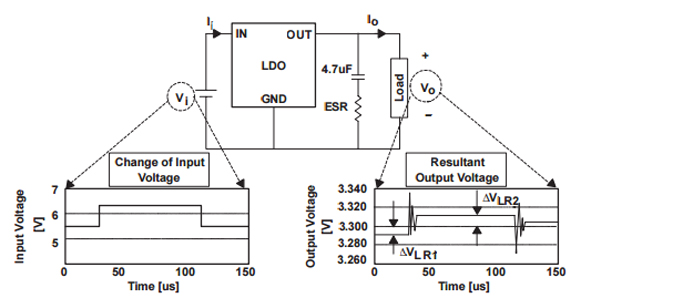What is Line Regulation?
Line Regulation is the change in output voltage due to variation of the input voltage with all other factors held constant. It is expressed as a percent of the nominal output voltage. A power supply with tight line regulation delivers optimum voltages throughout the operating range.
The line regulation gives the ability of a power supply to maintain the specified output voltage despite the changes or variations in the input line voltage. The value is calculated from the ratio of the change in the output voltage to the change in the input voltage, but usually expressed as a percentage:
Line Regulation = ΔVo/ΔVi
It is often desirable for a power supply to maintain a stable output regardless of changes in the input voltage, load or connected device. The line regulation is important when the input voltage source is unstable or unregulated and this would result in significant variations in the output voltage. And this might suffer from large voltage swings as it follows the input.
While the majority of DC power supplies convert AC from the mains to the DC output voltage required, there are some DC power supplies that rely on other auxiliary power sources to provide additional power for the power supply to achieve the required output. The line regulation is usually specified for power supplies that use the auxiliary power and may not be specified for the standard supplies that rely solely on the single mains supply source.
In voltage regulators such as the Low Dropout Output (LDOs), the manufacturers provide two specifications in regard to the regulation; the line regulation and the power-supply rejection ratio (PSRR).
The line regulation in this context shows the ability of the LDO to maintain its output regardless of changes in its input voltage.
Change in output voltage based on input voltage variation – Image Credit
The figure shows a typical response of the TPS76933 3.3 Volts LDO. If the input voltage to the regulator changes, the resulting output voltage will change and have different values at different input voltages. The line regulation is calculated from the ΔVLR1 and ΔVLR2. The line regulation parameter is usually a steady state parameter, which is a measure of the regulator’s open loop gain; with all the frequency components neglected. (i.e. at zero frequency). As such, the line regulation can be improved by improving the open loop gain,
The line regulation for an unregulated power supply is usually very high for a majority of operations, but this can be improved by using a voltage regulator. The quality of any power supply is dependent on the line regulation, load regulation and output resistance. A low line regulation is always preferred. In practice, a well regulated power supply should have a line regulation of at most 0.1%.
